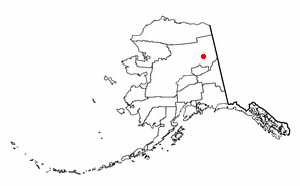Circle, Alaska
Circle (also called Circle City) is a town located in Yukon-Koyukuk Census Area, Alaska. As of the 2000 census, the population of the town is 100.
Circle is 260 km (162 miles) north of Fairbanks at the end of the Steese Highway. Circle was named by miners in the late 1800s who believed that the town was on the Arctic Circle. The Arctic Circle is actually about 80 km (50 miles) north of Circle.
Geography

Circle is located at 65°50'4" North, 144°4'35" West (65.834464, -144.076392)1.
According to the United States Census Bureau, the town has a total area of 280.3 km² (108.2 mi²). 278.9 km² (107.7 mi²) of it is land and 1.4 km² (0.5 mi²) of it is water. The total area is 0.50% water.
Demographics
As of the census2 of 2000, there are 100 people, 34 households, and 22 families residing in the town. The population density is 0.4/km² (0.9/mi²). There are 42 housing units at an average density of 0.2/km² (0.4/mi²). The racial makeup of the town is 14.00% White, 0.00% Black or African American, 76.00% Native American, 0.00% Asian, 0.00% Pacific Islander, 1.00% from other races, and 9.00% from two or more races. 4.00% of the population are Hispanic or Latino of any race.
There are 34 households out of which 29.4% have children under the age of 18 living with them, 11.8% are married couples living together, 32.4% have a female householder with no husband present, and 32.4% are non-families. 23.5% of all households are made up of individuals and 5.9% have someone living alone who is 65 years of age or older. The average household size is 2.94 and the average family size is 3.48.
In the town the population is spread out with 29.0% under the age of 18, 10.0% from 18 to 24, 27.0% from 25 to 44, 30.0% from 45 to 64, and 4.0% who are 65 years of age or older. The median age is 34 years. For every 100 females there are 100.0 males. For every 100 females age 18 and over, there are 115.2 males.
The median income for a household in the town is $11,667, and the median income for a family is $11,250. Males have a median income of $0 versus $23,750 for females. The per capita income for the town is $6,426. 42.0% of the population and 50.0% of families are below the poverty line. Out of the total population, 57.9% of those under the age of 18 and 0.0% of those 65 and older are living below the poverty line.
History
Circle was established in 1893 as an unloading point for supplies shipped up the Yukon River from the Bering Sea. The goods were sent overland to gold mining camps. In 1896, before the Klondike Gold Rush, Circle was the largest mining town on the Yukon River, with a population of 700. It had a store, a few dance halls, an opera house, a library, a school, a hospital, an Episcopal church, a newspaper, a United States commissioner, marshal, customs inspector, tax collector and a postmaster.
Circle lost much of its population after gold discoveries in the Klondike, in 1897, and Nome, in 1899. A few miners stayed near Circle and mining in the area continues to the present. Most of the people in Circle today are Athabascan.
